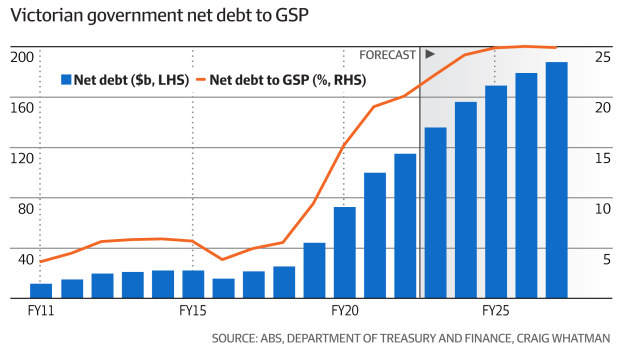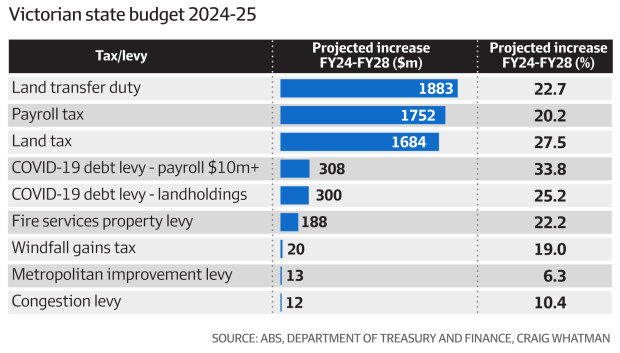This tree symbolises how Victoria became a financial basket case
After 300 years of withstanding the elements, the River Red Gum in Bulleen forced the North East Link to be redesigned as the cost of the project blows out by billions of dollars.
T
he 300-year-old river red gum in Melbourne’s Bulleen is the height of a seven-storey building and pre-dates white settlement. Victoria’s 2019 tree of the year is a symbol of everything that is wonderful, but possibly wrong, about the state of Victoria.
About 20 metres high, with a circumference of six metres, the tree was saved by locals when the rest of the block was cleared to make way for a Caltex service station.
In 2019, the tree was set to be felled to make way for the North East Link, which back then was expected to cost a modest $15.8 billion, up from an initial $10 billion.

The 300-year-old River Red Gum in Bulleen wins Victoria's tree of the Year in 2019. National Trust of Australia (Victoria)
It sparked a community and council campaign, with one 94-year-old resident telling 3AW radio he stopped a man with a chainsaw by brandishing a gun.
“I grabbed my BRNO rifle out of the car, ran over and said: ‘Touch that tree and I’ll kneecap you’,” Nevin Phillips said at the time.
The tree won out. “The tree has great significance to the local community and the design for North East Link was updated to avoid it,” the Victorian government announced after Premier Jacinta Allan was pulled into the controversy.
Who cares if the costs blow out if the state will pick up the tab?
Allan was also battling local councils that had joined the fight to protect parks, tennis courts and popular walking and cycling routes, including the Boroondara Tennis Centre (moved in a $21 million deal), Melbourne’s much-loved Italian Veneto Club and ovals belonging to Marcellin College, Trinity Grammar and Carey Baptist Grammar School. A new wetlands and Indigenous cultural precinct was also added.
Politically it is hard to argue with changes that benefit the community even when they come at a significant cost. As former premier Daniel Andrews told AFR Weekend when questioned about a $96 million package that included 60,000 Little Anglers Kits for primary school aged kids: “Well, if you’re opposed to little kids getting fishing rods, that’s fine, I’m not.”
In late December last year, Allan revealed the North East Link had blown out by another $10.3 billion. The premier blamed the majority – $3.1 billion – on higher costs for asphalt, steel and concrete caused by the “pandemic and Ukraine war”.
Another $2 billion was to extend the tunnel to 6.5 kilometres, $2.5 billion was for upgrades to the M80 and Eastern freeways, and $600 million was for noise walls.
CFMEU control
The Australian Financial Review this week spoke to one senior manager who worked on the project and revealed that builders were told they needed to use agreements with the militant CFMEU, despite the moderate Australian Workers Union having primary coverage of civil projects.
Contractors budgeted “at least” 15 per cent extra for a project that was CFMEU-run, and up to 30 per cent due to disruptions.
The manager, who asked not to be named, agreed with transport experts that there were also problems in the tender process and contracts that provide the Victorian government wears all the downside risk.

Prime Minister Anthony Albanese with CFMEU workers at Thursday’s North East Link announcement. Joe Armao
Toll road giant Transurban ruled itself out for the job and left just two other bidders with Spark Consortium awarded the contracts in 2021.
“The contractor doesn’t lose money,” the manager said. “There’s very minimum incentive for construction companies to run the job efficiently and effectively.
“Who cares if the costs blow out if the state will pick up the tab?”
Prime Minister Anthony Albanese was in Melbourne on Thursday delivering an extra of $3.2 billion – a total of $5 billion – for the most expensive road in the state’s history. Federal Opposition spokesperson Bridget McKenzie described it as “a bailout”.
Heroic assumptions
But the tree and the $26.1 billion toll road are a symbol of how Victoria’s finances -- laid bare in Tuesday’s state budget – became, in the words of economist Saul Eslake, a “basket case”.
Victorian Treasurer Tim Pallas delivered a $15.2 billion deficit, and revealed net debt will grow from $156 billion next year to $188 billion by 2028 with a daily interest bill of $26 million.
Net debt as a share of gross state product is projected to pass 25 per cent of the economy by 2026, far higher than the 16 per cent peak reached in the post-Cain-Kirner recession in 1993.

Prime Minister Anthony Albanese and Premier Jacinta Allan touring the North East Link site on Thursday. Joe Armao
In contrast, WestAustralian Treasurer Rita Saffioti this week handed down a $3.2 billion budget surplus. Another $8 billion in surpluses are forecast over the next three years.
WA’s debt of $32 billion is just 6.5 per cent of their gross state product. More than one business contact from WA told AFR Weekend most are left mystified by Victoria’s parlous financial state, saying it is considered a bit of a joke out west.
Despite the debt, Pallas avoided any really difficult decisions on Tuesday. There is no hold up in funding for Allan’s pet projects, the $125 billion Suburban Rail Loop, the $14 billion Metro Tunnel, and the $10.2 billion West Gate Tunnel.
There was a pause in Melbourne’s $10 billion Airport Rail Link which the Allan government has never strongly backed and know would never be ready by the next election in 2026.
Pallas says the main strategy is to grow the economy.

.
“A growing economy burns off the burden of debt,” he said this week.
The plan relies on a bullish 5 per cent growth projection and falling interest rates.
Ratings agency Moody’s, for one, is sceptical of Pallas’ assumptions that economic growth will outstrip government spending for the first time in 15 years.

Victorian Treasurer Tim Pallas JOE ARMAO
“We consider [it] may be difficult to achieve, given the upward pressure stemming from stubborn underlying inflation that will continue to drive higher employee expenses (employee expenses represent over 32 per cent of whole of government operating expenditure) and elevated interest rates amid the state’s high debt funding requirements,” Moody’s said.
The public sector wages bill alone will rise by 10 per cent over the next four years from $38 billion to $42 billion.
It was close to $19 billion when Pallas handed down his first budget 10 years ago.
Taxed to death
The government is also starting to appreciate that it can’t continue to raise taxes. Craig Whatman, a tax partner at Pitcher Partners, says business and investors are fleeing the state.
“Total tax revenue is expected to increase by more than $8 billion over the next five years,” he says. “That’s a 22 per cent increase.”
Victoria has 13,000 fewer new businesses compared with 2021 levels – and 8000 fewer in just over the past year. The long-time engine room of the state, population growth, reversed during the pandemic – and remains in flux.

And residential and commercial property investors are quitting Victoria. That’s reflected in the state’s housing forecasts, which have fallen to 52,000 from more than 70,000.
Victoria needs to build 76,000 homes a year to meet the federal housing target, and 80,000 a year to meet its own state goal of 800,000 new homes in the next decade.
At a recent Property Funds Association summit in Melbourne, one speaker declared two places in the world were uninvestable for property investors right now, China and Victoria.
Another declared that Victorian property had the same risk profile as India and Vietnam, but the rates of return were higher there.
Former Victorian Liberal leader Matthew Guy surprised most by making an impassioned speech in parliament last week which has been widely shared among the sector.
“It’s no good trying to lower one tax when you’ve added 53 others,” Guy roared. “And in the property sector they account for half of the 53.
“The property sector’s collapsing in this state because they are bearing the brunt of 27 new taxes in a decade. We said on this side of the house, ‘if you tax this industry to death, you will kill it’ and they have.”
Former Victorian premier Jeff Kennett, who embarked on a series of privatisations to help repay the Cain-Kirner debts of the 1990s admits there’s not much left to sell.
He says he is “crying for Victoria because we will pay a price for this well beyond my lifetime”.
“When we left government after the Cain-Kirner years we got our debt down to $5 billion, which was manageable, this is 37 times higher than that.”
Headline PR managing director and former Herald Sun editor Simon Pristel rates the budget 9 out of 10 “purely on spin, not economics”.
“I have no doubt that in the premier’s private office there will be thumbs-up emojis going around mobiles everywhere that they are just 24 hours on from the state budget, nobody is talking about it, it is not in the top five items on The Age or Herald Sun,” Pristel says.
“They spent weeks talking about a horror budget – there’s going to be cuts everywhere. We all braced ourselves for the rollercoaster and it didn’t really happen.”
It remains to be seen how much Victorian voters – who elected Andrews with an increased majority in 2022 and care deeply about the environment, Indigenous recognition and local institutions – really care about the state’s debt.
Perhaps when Victoria requires a federal bailout or when the $400 handouts and fishing rods dry up, the reality of the state’s debt pile may finally hit home.
Subscribe to gift this article
Gift 5 articles to anyone you choose each month when you subscribe.
Subscribe nowAlready a subscriber?
Introducing your Newsfeed
Follow the topics, people and companies that matter to you.
Find out moreRead More

Latest In Economy
Fetching latest articles